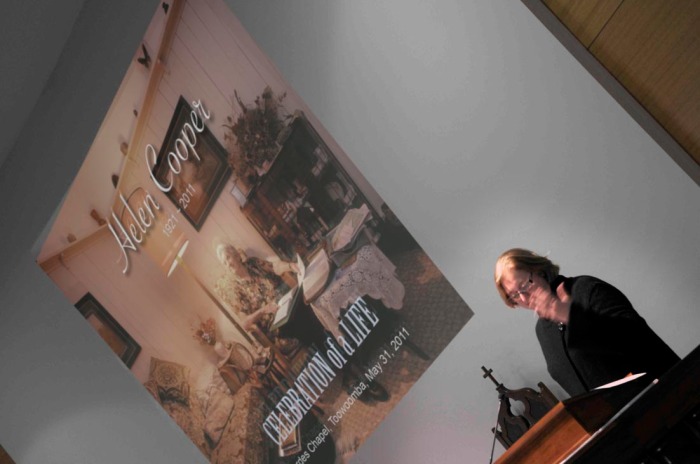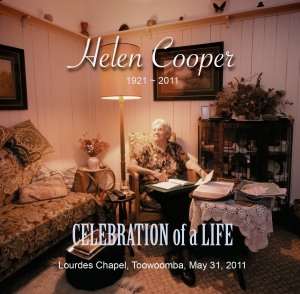May 30, 2011 – Celebration of a Life: Helen Cooper
Celebration of a Life: Helen Cooper
Susan Sontag in her seminal, although now somewhat aged, book On Photography stated that, ‘All photographs are momento mori. To take a photograph is to participate in another person’s mortality, vulnerability, mutability. Precisely by slicing out that moment and freezing it, all photographs testify to time’s relentless melt.’1
Vicky’s mother Helen passed away last week. Aged 89 Helen was quite a character and a local identity in Toowoomba. As part of a service to celebrate her life we assembled a photographic record of her life from images that she had gathered over the years as well as images from family and friends. Whilst the idea of a slide show is considered a standard part of any memorial service when we came to make our own, particularly as photographers, we were captivated by poignancy of the photographic image that we worked with.
Helen’s image collection traversed over half of the history of photography beginning with classic 1920s studio portraits, warm sepia family groups and dreamy high key pen-wash portraits. The oldest photograph is the youngest image of Helen is a snapshot: torn corners, creases, with the patina of being handled and held as a fragment of existence—perhaps even a cherished talisman in the journey of life.
The flow of images can only represent a small fraction of the life lived. Moments captured in a time and Place. Snaps of a young woman, full-length in the landscape, the bathing costume, and a young man appears, the young woman models on the beach full of the promise of life. The young man, Reg, becomes husband—a swatch of beautifully hand-coloured wedding prints attests to that, a house follows and then the first child, then two and soon there are three—another house, another baby.
The photographic process changes and as such identifies the passage of time. The photographs transition from 1930s soft black and white hand coloured studio portraits, to home processed contact prints, on to the gritty 1970s black and white and finally to the dominance of colour firstly from square colour images of 126 Kodak Instamatic cameras to contemporary digital.
The images depict a family growing up, having fun at Currumbin Bird Sanctuary, one graduates from university. The flow of life continues … weddings grand children – all come and visit Helen and Reg. In the middle years colour photographs emerge from the albums—a pink dress and Reg in a sunlit garden, a new home in a wilderness, a place that we now know is the metropolis of Coolum. New Guinea holidays, another image with Reg holding someone’s baby.
Then Helen faces a new life on her own, a new house—with the garden, family memories surround, and the photographs show meetings with family members, now older with their own grown up kids. More weddings, pictures with birds an ANZAC parade, a scene in a coffee shop—the images shift from Helen to two, and then three generations of Cooper. Helen grows older, family visits, church groups, breakfasts downtown—another hat, another . . . another
The photograph as Sontag once quipped is ‘incontrovertible proof’ of existence—but for whom is the proof required? Helen’s collected images were undoubtedly her memories, a record of moments – memorable ones. Moments that define a life and life shared. At the time of her passing the photographs become as Sontag suggests, ‘both a pseudo-presence and a token of absence’. 2
The images in this sequence present both presence and absence—photographs provide a poignant bridge to what has been, memories and an understanding of a life well lived.
1 On Photography, Susan Sontag, 1979, Penguin Books, page 15
2 ibid, page 16


Leave a comment